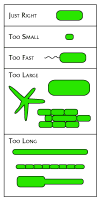Bacterial morphology: why have different shapes?
- PMID: 17981076
- PMCID: PMC2169503
- DOI: 10.1016/j.mib.2007.09.009
Bacterial morphology: why have different shapes?
Abstract
The fact that bacteria have different shapes is not surprising; after all, we teach the concept early and often and use it in identification and classification. However, why bacteria should have a particular shape is a question that receives much less attention. The answer is that morphology is just another way microorganisms cope with their environment, another tool for gaining a competitive advantage. Recent work has established that bacterial morphology has an evolutionary history and has highlighted the survival value of different shapes for accessing nutrients, moving from one place to another, and escaping predators. Shape may be so important in some of these endeavors that an organism may change its morphology to fit the circumstances. In short, if a bacterium needs to eat, divide or survive, or if it needs to attach, move or differentiate, then it can benefit from adopting an appropriate shape.
Figures


References
-
- Beveridge TJ. The bacterial surface: general considerations towards design and function. Can J Microbiol. 1988;34:363–372. - PubMed
-
- Koch AL. What size should a bacterium be? A question of scale. Annu Rev Microbiol. 1996;50:317–348. - PubMed
-
- Mitchell JG. The energetics and scaling of search strategies in bacteria. American Naturalist. 2002;160:727–740. An exquisitely detailed, far-ranging discussion of how the physical requirements imposed by motility influence and constrain bacterial shape. - PubMed
Publication types
MeSH terms
Grants and funding
LinkOut - more resources
Full Text Sources

